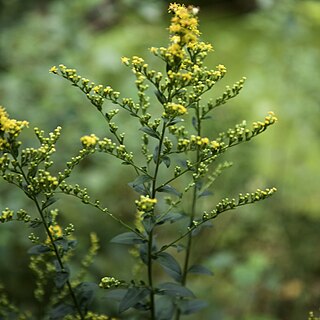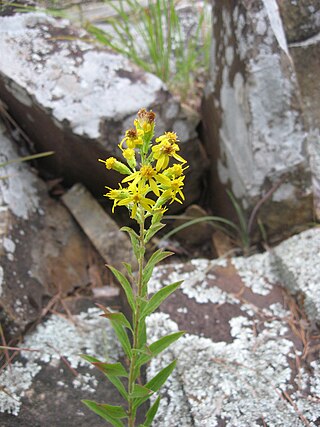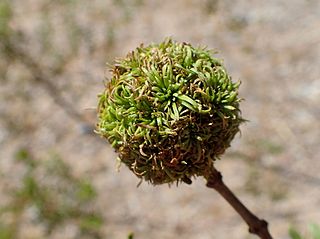
Solidago juncea, the early goldenrod, plume golden-rod, or yellow top, is a North American species of herbaceous perennial plants of the family Asteraceae native to eastern and central Canada and eastern and central United States. It grows from Nova Scotia west to Manitoba and Minnesota south as far as northern Georgia and northern Arkansas, with a few isolated populations in Louisiana and Oklahoma.

Creosote gall midges are a species of gall-inducing flies in the Asphondylia auripila group. This group consists of 15 closely related species of flies which inhabit creosote bush sensu lato. They have partitioned the plant ecologically with different gall midge species inhabiting the leaves, stems, buds, and flowers of creosote bush. Each species induces a uniquely shaped gall but the insects are otherwise morphologically very similar and very difficult to tell apart.

Solidago caesia, commonly named blue-stemmed goldenrod, wreath goldenrod, or woodland goldenrod, is a flowering plant native to North America.

Solidago altissima, the tall goldenrod or late goldenrod, is a North American species of goldenrod in the family Asteraceae which is widespread across much of Canada, the United States, and northern Mexico. It is common in much of its range and fairly tolerant of landscapes which have been disturbed by humans. It has become naturalized in many parts of the world.

Solidago patula, the roundleaf goldenrod or rough-leaved goldenrod, is a species of goldenrod found in wetlands, especially swamps, fens, and sedge meadows. It is native to most of the eastern United States, as far west as Wisconsin and Texas. It is a perennial herb. There are two subspecies.

Borrichia frutescens is a North American species of flowering plants in the family Asteraceae known by the common names sea oxeye, sea oxeye daisy, bushy seaside tansy, and sea-marigold. In Veracruz it is called verdolaga de mar. It is native to the United States and Mexico, where it occurs along the Atlantic and Gulf Coasts. Its distribution extends from Maryland south to Florida and west to Texas in the US, and along the Mexican Gulf Coast to the Yucatán Peninsula. It is an introduced species in some areas, such as Bermuda and Spain.

Solidago petiolaris is a North American species of goldenrod commonly called the downy ragged goldenrod. It is native to the United States and Mexico, in every coastal state from Texas to North Carolina, inland as far as southern Illinois, southern Nebraska, northeastern New Mexico, and Coahuila. Its preferred habitat is sandy areas.

Asphondylia is a cosmopolitan genus of gall midges in the family Cecidomyiidae. All species in this genus induce galls on plants, especially on flowers and flower buds. There are over 300 described species in Asphondylia, with many more likely to be discovered and described, especially in the southern hemisphere.

Asphondyliini is a tribe of gall midges in the family Cecidomyiidae. There are about six genera and at least 100 described species in Asphondyliini.
Asphondylia websteri, the alfalfa gall midge, is a species of gall midges in the family Cecidomyiidae.

Asphondylia auripila is a species of gall midge in the family Cecidomyiidae. It forms galls on Larrea tridentata stems.
Asphondylia prosopidis, the mesquite gall midge, is a species of gall midges in the family Cecidomyiidae.

Asphondylia floccosa, the woolly stem gall midge, is a species of gall midges in the family Cecidomyiidae. The larvae induce galls on Atriplex polycarpa. They don't feed on the gall itself, but rather fungus that grows within the gall. Each gall can contain anywhere from one to fifteen chambers. This species is known from Arizona and California, and was first described by American entomologist Raymond Gagne in 1968.
Asphondylia ceanothi, the ceanothus bud gall midge, is a species of gall midges in the family Cecidomyiidae.

Asphondylia solidaginis is a species of gall midge (Cecidomyiidae) that induces galls on goldenrods in North America where it is widespread. It was first described by William Beutenmuller in 1907.
Asphondylia monacha is a species of gall midges in the family Cecidomyiidae.
Asphondylia ambrosiae is a species of gall midge in the family Cecidomyiidae.
Asphondylia amaranthi is a species of gall midge in the family Cecidomyiidae.
Asphondylia antennariae is a species of gall midge in the family Cecidomyiidae. The larvae of this species induce galls on the buds of Antennaria plantaginifolia. This species is known from Wisconsin and Maine in the United States, though it's host plant is widespread in eastern North America. It was first described by American entomologist William Morton Wheeler in 1889.
Asphondylia artemisiae is a species of gall midge in the family Cecidomyiidae. The larvae of this species induce galls on at least one species of sagebrush Artemisia (plant). This species is only known from Arizona in the United States. It was first described by American entomologist Ephraim Porter Felt in 1908.










